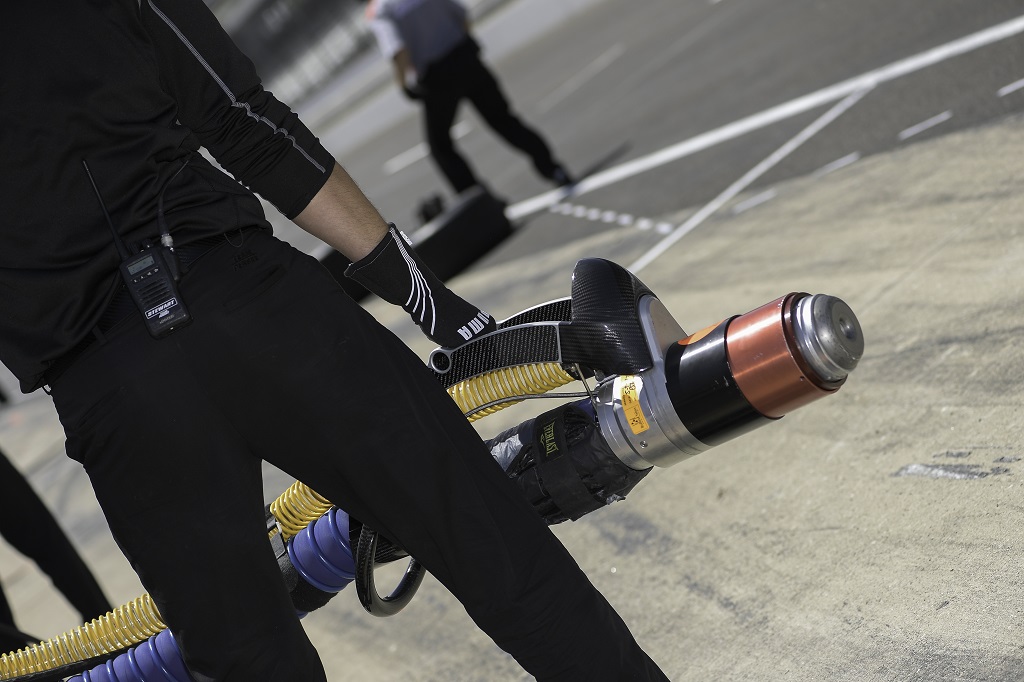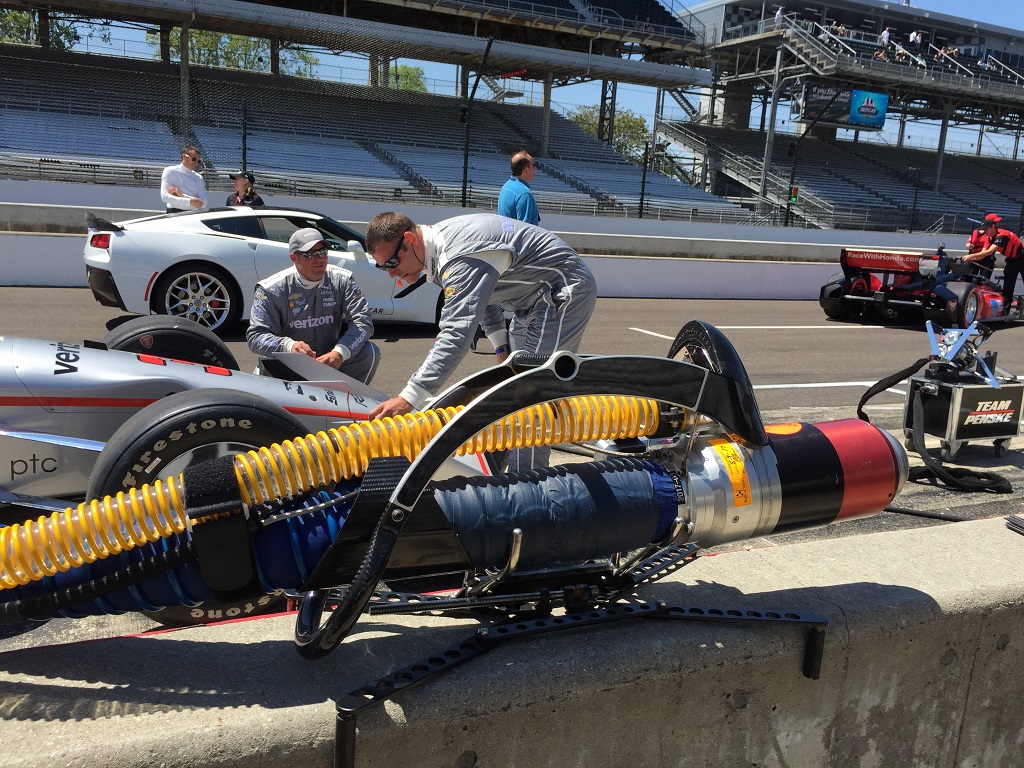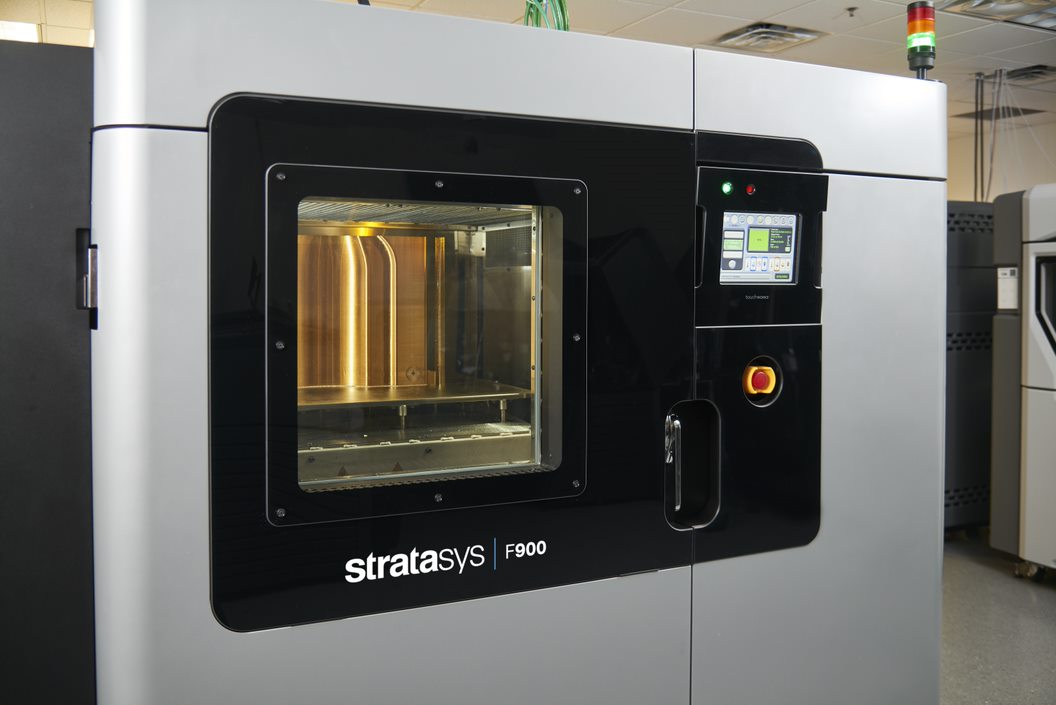![F900 Production 3D Printer [Image: Stratasys]](https://fabbaloo.com/wp-content/uploads/2020/05/f900_img_5eb0a7b37f907.jpg)
Stratasys’ Vice President of Manufacturing provides insights into strong steps forward.
High-strength 3D printing for prototyping and production is in focus for Stratasys as the company deepens its relationship with Team Penske and showcases its carbon fiber solutions at IMTS. Ahead of today’s show opening, I caught up with VP of Manufacturing Scott Sevcik for a chat about what we can expect from the leading company as IMTS hosts the biggest players in the 3D printing industry.
Carbon fiber is in the Stratasys spotlight this week, with the company demoing its Fortus 380mc Carbon Fiber Edition and F900 Production 3D Printer on the show floor. Team Penske, a well-known American professional racing team, offers a major use case, as this partnership has been expanded.
“Our partnership with Team Penske really has mutual benefit,” Sevcik told me. “What we feel is very important as we set our technology roadmaps with new technologies, systems, and software: we want to make sure we understand the real issues our end users are facing. Partnerships like what we have with Team Penske make sure that we can be on the ground, understanding opportunities and what can be better. They get us as close partners, sharing the ins and outs of technology, identifying ways of using the technology they may not have thought of, and the benefit of moving quickly and having access to experts.”
Over the last year and a half, he continued, working closely with Team Penske has provided Stratasys the “opportunity to explore a pretty wide range of applications of direct benefit to Team Penske as a race team, and for broader use.”
Importantly, these uses expand beyond prototyping, though Sevcik was quick to note that that remains a definite application area. Carbon fiber capabilities are enabling additional uses, though, such as tooling and as a way to create lighter-weight end-use vehicle components.


“Producing tooling can be time-consuming, and the team doesn’t have time for that to enhance performance from one week to the next. Being able to create composite layout tools has been of significant benefit to the team. Even creating simple fixtures for a variety of features required, for locating holes for drilling or locating multiple pieces for an assembly process, the ability to customize that quickly has been beneficial for Team Penske on the ground. Beyond that, they have identified a number of applications impacting the vehicle itself, including printing parts for the vehicle, for crew helmets, for a variety of support equipment or for the vehicle itself,” he explained.
With such breadth of applications, for Stratasys the vision is clear: 3D printing is changing the shape of manufacturing.
Operations like Team Penske’s are “a great microcosm to look more broadly at manufacturing,” Sevcik continued. The automotive industry has been a major adopter of advanced technologies, and Stratasys is very familiar with the unique needs of this fast-moving (pun intended) industry. The demanding performance environment for automotive production and the need to change designs quickly means that in automotive, particularly in racing, there is “an acceleration in the cycle throughout industry…a need for differentiation, for customization, for lightweighting, for that aspect of continuous improvement,” he said.
Earlier tech introductions from Stratasys, such as the Infinite Build Demonstrator, fit well within the automotive industry’s range of needs — and indeed, at the last IMTS, in 2016, we saw the company demonstrating its Demonstrator.
Among the use cases Sevcik covered in their work with Team Penske was the creation of a 3D printed tool that took about four seconds out of the cycle time compared to the original process. While four seconds may not seem terribly significant, he noted, “used 255,000 times per year, that adds up to about a month of labor. Those things where we’re trying to get seconds or minutes off to get more done, and scale that out to broader industry, the results can be quite dramatic. We’re seeing that on the factory floor, and throughout manufacturing more broadly.”
I asked about the machines that will be featured at IMTS 2018. Sevcik noted that with carbon fiber nylon standing as “one of the stiffest materials out there,” Stratasys’ targeted offerings provide a “good look at where FDM technology can go, where few processes, additive or otherwise, dare to go.” The Fortus 380mc Carbon Fiber Edition can, he noted, 3D print a side view mirror housing that has ridden on a Team Penske NASCAR automobile.
“It’s a material and a system to deliver that material in a repeatable fashion to put parts on vehicles,” he said.
![[Image: Stratasys]](https://fabbaloo.com/wp-content/uploads/2020/05/penske-2018b_img_5eb0a7b523992.jpg)
For its part,the F900 Production 3D Printer is “really the premier production system out there,” as Stratasys sees it, as the machine can deliver materials including carbon fiber-reinforced nylon and ULTEM 9085. Applying these high-performance materials to the larger scale factor of the F900, he noted, allows for more opportunity for industry, and on “one of the only systems out there able to stream real-time process data” to allow for inspection of each build job.
IMTS, one of the world’s largest manufacturing technology trade events, offers more than one million square feet of exhibit space. While additive manufacturing was present in 2016, the AM Pavilion was a relatively tiny percentage of that floor space. The size is increasing this year, as are the announcements already rolling in, but the overall show remains primarily geared toward traditional technology. So where does Stratasys hope to fit in amongst the milling?
“When we look at additive as a manufacturing technology, what it will eventually become is indistinguishable from other technologies, from the benefits to the part itself. When you look at a part as a manufacturer, it doesn’t matter which technology you’re using; you’ll use the one with the best value, the right part for the job,” Sevcik told me.
“Today, additive manufacturing is something different, distinct. When we’re looking at implementing additive, it’s a specialized look, it’s new; it’s appropriate early on to look at first getting to know the technology. Long-term, it will be, this is the part I need to produce and how to produce it, whether that’s additive, subtractive, thermoforming, whatever — at a certain point that’s irrelevant. What we’re seeing in the industry, as we have additive manufacturing equipment really crossing the maturity threshold as production equipment, is how are we ensuring that workflow is not unique, that we’re not making customers do special things because it’s additive?”
And how do we know that additive is actually maturing? The key is in repeatability.
For the F900, Sevcik noted, they are able to claim “very high part repeatability with a low coefficient of variance. Every part produced, there’s no question of, will this be stronger or weaker, that range of variability is down tightly.” With ULTEM 9085 in particular, they have gotten the coefficient of variation below 5% for an aircraft configuration solution, representing “very, very high repeatability as good as or better than other technologies.”
Also in consideration are standards, interconnectivity, and design simulation and analysis. In each of these areas, Stratasys is working with a variety of strong partners to move forward and develop deliverable solutions for industry.
“We need to replicate the toolsets engineers expect with other technologies and integrate those same needs and capabilities for an additive technology. These are the key signs we should be looking for to shift 3D printing from being something different to something really fitting into the mainstream of production technologies, where true values of the technology are the centerpoint; it’s not about being something different that customers are being asked to adapt to,” he said.
![Scott Sevcik, Vice President of Manufacturing, Stratasys [Image via LinkedIn]](https://fabbaloo.com/wp-content/uploads/2020/05/scottsevcik_img_5eb0a7b57fe62.jpg)
The greatest push in the additive manufacturing industry is that manufacturing focus, Sevcik said, emphasizing that “Stratasys is in the center of that.”
For all the discussion of the movement into manufacturing, however, “there should be recognition that it’s there.” 3D printing for tooling and for production “are real and are creating a lot of value today,” Sevcik added. This has been coming about due to the focus placed on the needs of manufacturers, and to the maturation of 3D printing technologies. “Look at FDM; it’s now a 30-year-old technology, and 30 years is about right for moving a technology from inception to the level of repeatability and performance to be trusted in critical applications,” he said.
I look forward to speaking with team Stratasys on-site at IMTS this week for a closer look at the real-world opportunities for additive in manufacturing.
Via Stratasys

